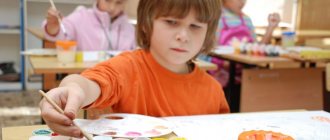Daily routine in kindergarten
The routine in kindergarten is the same for all children.
Therefore, if at home you are used to sleeping until lunch, not putting your child to bed and eating whenever you want, then before entering a preschool institution you need to bring your home daily routine as close as possible to the routine in kindergarten. This will help the child during the adaptation period. Typically, three-year-olds easily adapt to kindergarten. At this age, they are ready to communicate with their peers and other adults and gain new knowledge. Being raised at home, the child does not receive the necessary social communication. In addition, in kindergarten, classes with the child are conducted according to a special program that corresponds to his age characteristics.
In a group of peers, it is much easier for a child to learn to communicate or gain self-service skills by looking at other children. And in order for your child to endure the adaptation period even easier, you need to accustom him to the regime within 2-3 months. It is very difficult to maintain a rigid daily routine at home. And in kindergarten it is built optimally for a little person and contributes to his physiological and psychological development.
The regime in different kindergartens may differ, but its principle is the same everywhere.
Approximate daily routine in kindergarten
Meals and sleep remain constant in the daily routine. The walk depends on weather conditions and time of year. If the weather is bad, games or activities are held at this time. Some kindergartens also have a second breakfast.
Do you want to know the microclimate of your family? Take the TEST ON OUR WEBSITE and find out if anything needs to be changed
Also read on our website: Riddles about winter for children
Requirements for the daily routine in kindergarten according to SanPiN
Children are provided with four meals a day at the group premises. The interval between meals is no more than 4 hours. For more information about diet, diet and menu, see here.
A walk is organized 2 times a day: in the first half of the day and after sleep, which is a total of 3 - 4 hours. At temperatures below -15°C and wind speeds of more than 7 m/s, the duration of the walk is reduced.
Daytime sleep for children from 3 to 7 years old is 2 - 2.5 hours. During nap time, the presence of a teacher in the bedroom is mandatory. Before going to bed, it is not recommended to conduct active and emotional games and activities.
Independent activity of children 3–7 years old should take at least 3–4 hours a day. This includes independent play, preparation for educational activities, and personal hygiene.
All rooms must be ventilated daily. Through ventilation is carried out at least 10 minutes every 1.5 hours in the absence of children, 30 minutes before they arrive from a walk or activity. In the presence of children, ventilation is permissible only in the warm season without a draft. When ventilating, the air temperature should not drop by more than 2-4°C.
Bed linen is changed at least once a week.
Have you already chosen what to give your baby for New Year? How to please and surprise your beloved baby? The New Year family holiday is an opportunity to give your child bright emotions from shared entertainment. Let your baby remember this magic and fairy tale for the rest of his life! The best New Year's greetings for a baby - personal interactive greetings!
One of the reviews from a caring grandfather: “My granddaughter was still very young when I bought her the very first disc. To say that it is magical is to say nothing! The cub sat with his mouth open and believed that it was really Santa Claus talking to her. I bought it every year and never regretted it. Now, of course, she’s grown up and it’s difficult to surprise her with Santa Claus... Thank you for being able to give your baby a fairy tale for the New Year!”
Download the series as a New Year's gift and you will see how much happiness your child will receive from watching the fairy-tale game plot! Look at all the unusual options for New Year's greetings for your baby HERE!
Organization of classes
It is mandatory for the harmonious development of the child to include developmental activities in the daily routine according to SanPiN, which subsequently serve as preparation for school.
Also read on our website: Crafts with your child: paper boxes using a ready-made template
Classes in kindergarten are conducted in the main areas:
- musical;
- physical training;
- art;
- classes to develop fine motor skills;
- speech development classes;
- introduction to basic mathematical knowledge.
Activities that require increased cognitive activity and mental stress of children are held in the first half of the day and alternate with physical education and music classes to avoid overworking the child.
The continuous duration of an educational lesson for a preschooler does not exceed:
- 10 minutes for children 3 - 4 years old (younger group);
- 15 minutes for children 4 - 5 years old (middle group);
- 20 minutes for children 5 - 6 years old (older group);
- 30 minutes for children 6 - 7 years old (preparatory group).
No more than 3 classes are held per day. Breaks between classes are at least 10 minutes.
Physical development classes
Physical development classes are held at least 3 times a week. Their duration ranges from 15 to 30 minutes depending on the age group. In summer, such activities are recommended to be carried out outdoors.
In addition to physical development classes, other forms of physical activity are also used: morning exercises, physical exercises, outdoor games, and in some kindergartens - exercise classes, swimming, etc.
Morning reception for children
Reception of children should be carried out by educators and (or) medical workers. Identified sick children or children with suspected illness are not accepted. If a child falls ill during the day, he is isolated from healthy children (placed in a medical room) until the parents arrive or are hospitalized, with the parents informed.
If you don't follow a daily routine
If parents are illogical in observing the children’s daily routine, then they force the child to follow it, then they let everything take its course, this negatively affects the baby’s nervous system. He may have the following health problems.
- Moodiness, irritability, nervousness
- Fast fatiguability
- Changes in activity and rest
- Mood swings
- Lack of sleep, poor sleep
- Poor appetite
- Insufficient assimilation of information
- Reluctance to clean up after yourself or help your mother
Age characteristics of a child 1-1.5 years old
When a child turns one year old, he begins to develop more rapidly than before. And at the same time, a child at this age still has many inconsistencies. Physically, the child is not yet able to withstand the whole day without sleep; he gets tired quickly. At the same time, the child loves to run and jump a lot and actively, however, he gets tired very soon and needs rest. The child’s coordination of movements is still insufficient, despite the fact that he wants to play for a long time and a lot.
A child at this age can fulfill an adult’s request to bring or serve something, and his active vocabulary begins to quickly expand. A child at this age throws away the pacifier and begins to eat with a spoon. True, it sheds a lot at the same time.
Activity of a child 1-1.5 years old throughout the day
As we have already figured out, the baby sleeps for about 4-4.5 hours during the day. The same amount of time is spent on the period of activity. Changing the daily routine, that is, reducing the period of sleep or period of activity, should not be done, because this may have an undesirable effect on the child’s health. The child may suffer from increased fatigue or, conversely, lethargy.
To make the child’s activity more varied throughout the day, it is necessary to include bathing and educational games in the daily routine. Books, bright toys, pyramids, cubes are a very good way to diversify the waking period of a child aged 1-1.5 years.
What should you teach a 1-1.5 year old child?
At this age, it is imperative to teach your child to wash his hands, brush his teeth, and use a spoon, napkin, and potty.
Daily routine for a child from 1 to 1.5 years old
| Kind of activity | Time |
| Feeding | 7.30, 12.00, 16.30, 20.00 |
| Wakefulness | 7.00 – 10.00, 12.00 – 15.30, 16.30 – 20.30 |
| Dream | First sleep – 10.00 – 12.00, second – 15.30 – 16.30, night sleep – 20.30 – 07.00 |
| Walk | after lunch and afternoon tea |
| Bathing | 19.00 |
Sleep of a child 1-1.5 years old
Daytime naps should be scheduled twice in the schedule of a child of this age. The first time the child should sleep from two to 2.5 hours, and the second time - up to two hours.
In order for the child to fall asleep normally, you need to stop active games half an hour before. It is ideal if the child takes a walk with his mother in the fresh air an hour before bedtime. This way his nervous system will calm down, blood flow will be activated, and the blood will be more saturated with oxygen. It is very important that every day the sleep schedule, as well as other activities of the child, is planned at the same time. This way the child will develop habits and conditioned reflexes that will allow him to follow the schedule in the future and not disrupt his sleep and activity patterns.
When you teach your child to go to bed at the same time, you need to wake him up at the same time. True, it is permissible to “overstay” the baby for 15 minutes or wake him up a quarter of an hour earlier, if this is convenient for the child. After sleep, you need to start teaching your child to dress himself, helping him and showing him how to do it. At the same time, you need to show the baby the clothes and name them.
Sleeping in the fresh air is good in summer. In the cold season, before putting a 1-1.5 year old child to bed, you need to thoroughly ventilate the room. But the baby should not sleep in a draft - he will get sick.
How many times should I feed a child aged 1-1.5 years?
Feeding should not be less than four times a day. Approximately 3-4 hours should pass between feedings. After feeding, the baby should take a walk. And then you can get some sleep, and after sleep the baby is fed again. With this daily routine, the child grows and develops well. After sleeping and eating, the child is calm, plays well, is not capricious, his nervous system is calmer than those of those children who do not get enough sleep and are malnourished.
When you spoon feed your baby and teach him to use this device on his own, you can use a little trick. If a child cannot eat from a spoon, you need to put thick food into it first, and then, when everything starts to work out, you can scoop out liquids with a spoon: soup, jelly. There is no need to overexert the child: let him learn just a little, 3-4 spoons are enough, and then dad or mom will feed the baby. At the end of feeding, you can use a bonus for the baby - allow him to finish himself with a spoon when there is very little food left.
Bathing and hardening
Before afternoon tea you need to give your child a bath. If not bathing, then rubbing, it is also very useful for hardening. First they wipe the child's arms, then the chest, then the legs, then the back. The water temperature should be no higher than 35 degrees Celsius. To harden a baby under the age of one and a half years, you can gradually reduce the water temperature. Once a week or five days, when bathing and drying, reduce the water temperature by 5 degrees, resulting in a water temperature of 24 degrees. You should not give up hardening - it greatly strengthens the child’s nervous, immune and respiratory systems.







